
The Cabinet of Curiosities section of the exhibition How to Collect Art: The Karel Tutsch Story introduces visitors to Karel Tutsch’s early collecting activities through a set of ex libris – a collection of small-scale applied graphic art. From here, Tutsch’s interests logically expanded to include fine art prints. Over time, the Cabinet of Curiosities will present various artists and their works on paper that form an indispensable part of the collection.
Detail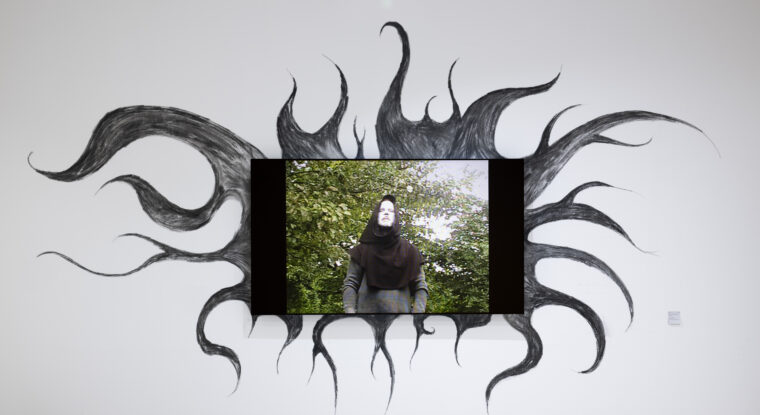
The concept of the historically focused collection exhibition How to Collect Art: the Karel Tutsch Story will be expanded by a series of exhibitions of the youngest generation of artists, current students or graduates from art school studios. In this way, the curators will revive Tutsch’s basic strategy of discovering and presenting the works of previously unknown artists in a new context. Gallery Na bidýlku II will thus become a laboratory for new approaches to the traditional medium of painting and installation, whose transformations Tutsch has followed and supported for several decades.
Detail
Human Frontiers, the final presentation of an eponymous project, consists of a uniform compact object designed especially for the entry area of the Gallery of Modern Art in Hradec Králové. The installation is a group portrait compiled from individual contributions by various students from the University Hradec Králové’s Department of Art, Visual Culture, and Textile Studies who participated in this research project.
Detail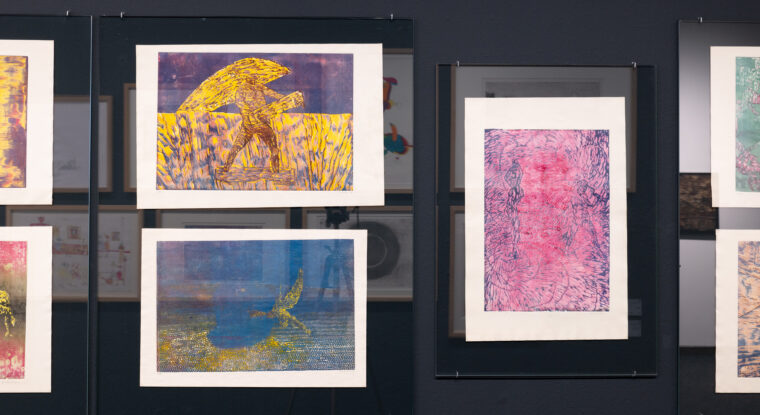
The Cabinet of Curiosities section of the exhibition How to Collect Art: The Karel Tutsch Story introduces visitors to Karel Tutsch’s early collecting activities through a set of ex libris – a collection of small-scale applied graphic art. From here, Tutsch’s interests logically expanded to include fine art prints. Over time, the Cabinet of Curiosities will present various artists and their works on paper that form an indispensable part of the collection.
Detail
The concept of the historically focused collection exhibition How to Collect Art: the Karel Tutsch Story will be expanded by a series of exhibitions of the youngest generation of artists, current students or graduates from art school studios. In this way, the curators will revive Tutsch’s basic strategy of discovering and presenting the works of previously unknown artists in a new context. Gallery Na bidýlku II will thus become a laboratory for new approaches to the traditional medium of painting and installation, whose transformations Tutsch has followed and supported for several decades.
Detail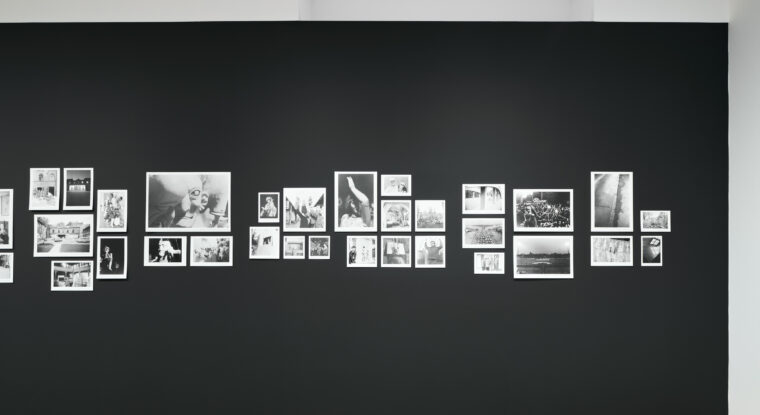
The exhibition at GMU’s White Cube takes a unique look at the changing face of Hradec Králové between 1954 and 1984 through photographs taken by two local personalities – Zdeněk Merta (b. 1955) and, to a lesser extent, his father Jan (1927–2022). The exhibited black-and-white photographs represent only a fraction of the family’s extensive archive, with the last images dating to 1984, the year Zdeněk moved to Prague.
Detail
The Gallery of Modern Art in Hradec Králové presents two exhibitions by artist Matěj Smetana (b. 1980), organized as part of the city’s celebration of the 800th anniversary of its founding. The first, titled We Are the World (2008–2015), consists of flags installed in various public places around the city. The second, Moonlight Sonata (2025), can be seen in the gallery’s Black Cube exhibition space. In addition, at the exhibition opening the artist will present a performance titled Moonlight Sonata.
Detail
Exhibition Forgotten Masters. The Changing Nature of Artistic Success presents the works of ten painters who came last in a visitor poll held as part of the exhibition The Search for a Masterpiece (8 October 2023 –26 May 2024) and who have long been overlooked by art history. In recent decades, there have been very few, if any, exhibitions or monographs on them.
Detail
The Cabinet of Curiosities section of the exhibition How to Collect Art: The Karel Tutsch Story introduces visitors to Karel Tutsch’s early collecting activities through a set of ex libris – a collection of small-scale applied graphic art. From here, Tutsch’s interests logically expanded to include fine art prints. Over time, the Cabinet of Curiosities will present various artists and their works on paper that form an indispensable part of the collection.
Detail
The concept of the historically focused collection exhibition How to Collect Art: the Karel Tutsch Story will be expanded by a series of exhibitions of the youngest generation of artists, current students or graduates from art school studios. In this way, the curators will revive Tutsch’s basic strategy of discovering and presenting the works of previously unknown artists in a new context. Gallery Na bidýlku II will thus become a laboratory for new approaches to the traditional medium of painting and installation, whose transformations Tutsch has followed and supported for several decades.
Detail
The Black Cube, a space for exploring the moving image in works by selected artists, presents Static Drama by photographer and visual artist Alena Kotzmannová. The exhibition features works from the collections of the Gallery of Modern Art in Hradec Králové along with several of Kotzmannová’s other works.
Detail
Trapped Emotions is an intergenerational artistic dialogue between two truly distinctive representatives of Czech art. The first, Luděk Rathouský, is an unwavering solitary force in Czech painting and a member of that generation of artists whose work at the start of the new millennium was shaped by conceptual thinking. The second, Zbyněk Sekal, is a painter, draughtsman and sculptor from the generation that evolved from the groundwork laid by Czech informel in the late 1950s and early 1960s.
Detail
The Cabinet of Curiosities section of the exhibition How to Collect Art: The Karel Tutsch Story introduces visitors to Karel Tutsch’s early collecting activities through a set of ex libris – a collection of small-scale applied graphic art. From here, Tutsch’s interests logically expanded to include fine art prints. Over time, the Cabinet of Curiosities will present various artists and their works on paper that form an indispensable part of the collection.
Detail
The concept of the historically focused collection exhibition How to Collect Art: the Karel Tutsch Story will be expanded by a series of exhibitions of the youngest generation of artists, current students or graduates from art school studios. In this way, the curators will revive Tutsch’s basic strategy of discovering and presenting the works of previously unknown artists in a new context. Gallery Na bidýlku II will thus become a laboratory for new approaches to the traditional medium of painting and installation, whose transformations Tutsch has followed and supported for several decades.
Detail
Ladislav Beneš (1883–1956) was one of the leading representatives of Czech neoclassicism in the first half of the 20th century. His works are a sophisticated synthesis of modernist and traditional elements. They reflect the fascination with speed, movement and technological progress that was typical for the interwar era. Automobiles, motorcycles and aeroplanes had become symbols of a new and dynamic world, and Beneš, as a member of the emerging generation of sculptors, was aware of these changes. Alongside his colleague Jan Štursa, with whom he shared a passion for the art of Auguste Rodin, he went in search of a new artistic style centred around the human figure that
would also reflect this fascination with movement.

Jan Šerých produces a highly diverse body of work. A painter at first, he later – influenced by new media – began working with computers and the internet. Another integral aspect of his abstract and minimalist work is printing. Šerých works with found information that he pulls out of their timeless or virtual context – pictures, images from Google, information, data, symbols, codes and text. Many of these references have multiple meanings, and their meaning and humour deliberately produce a sense of disorientation in the viewer. When we look at Šerých’s works, we can usually decide whether we want to look at them or read them.
Detail
The Cabinet of Curiosities section of the exhibition How to Collect Art: The Karel Tutsch Story introduces visitors to Karel Tutsch’s early collecting activities through a set of ex libris – a collection of small-scale applied graphic art. From here, Tutsch’s interests logically expanded to include fine art prints. Over time, the Cabinet of Curiosities will present various artists and their works on paper that form an indispensable part of the collection.
Detail
The concept of the historically focused collection exhibition How to Collect Art: the Karel Tutsch Story will be expanded by a series of exhibitions of the youngest generation of artists, current students or graduates from art school studios. In this way, the curators will revive Tutsch’s basic strategy of discovering and presenting the works of previously unknown artists in a new context. Gallery Na bidýlku II will thus become a laboratory for new approaches to the traditional medium of painting and installation, whose transformations Tutsch has followed and supported for several decades.
Detail
British artist Henry Moore (1898–1986) is considered a leading representative of modern sculpture whose work influenced individual artists as well as entire stylistic tendencies. Working with a detailed chronology, the exhibition explores the diplomatic framework and other mechanisms involved in the presentation and reception of Moore’s art during the Cold War. Mainly, however, it looks at his work’s influence on Czechoslovak sculpture in the second half of the 20th century.
Detail
The exhibition by Polish filmmaker, video artist and creator of photographs, installations and drawings Józef Robakowski (b. 1939) provides a glimpse into different aspects of his work, primarily from the 1960s to the 1990s. It also shows him in his role as an art collector, a member of various art groups and an organiser of exhibitions and other independent art activities. The exhibition includes films and photographs acquired by GMU in 2023, plus works on loan from the artist’s archives and from the National Museum in Wroclaw (Muzeum Narodowe we Wrocławiu).
Detail
Jaroslava Severová (b. 1942) is a leading figure in the field of Czech graphics, although her body of work dating back to the 1960s encompasses a far broader scope that also includes painting, object art, the design of architectural elements and photography. Additionally, since the 1990s she has worked with computer graphics and digital printing. The exhibition at the gallery’s White Cube has been conceived as a “dialogue” between the artist’s early works from the GMU collections and her more recent creations.
Detail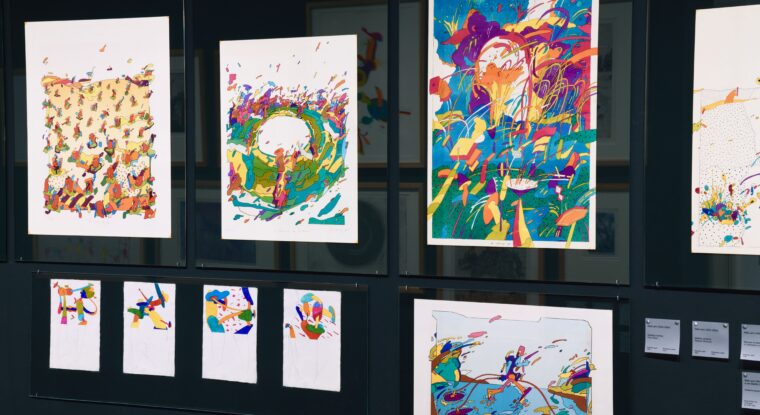
The Cabinet of Curiosities section of the exhibition How to Collect Art: The Karel Tutsch Story introduces visitors to Karel Tutsch’s early collecting activities through a set of ex libris – a collection of small-scale applied graphic art. From here, Tutsch’s interests logically expanded to include fine art prints. Over time, the Cabinet of Curiosities will present various artists and their works on paper that form an indispensable part of the collection.
Detail
The concept of the historically focused collection exhibition How to Collect Art: the Karel Tutsch Story will be expanded by a series of exhibitions of the youngest generation of artists, current students or graduates from art school studios. In this way, the curators will revive Tutsch’s basic strategy of discovering and presenting the works of previously unknown artists in a new context. Gallery Na bidýlku II will thus become a laboratory for new approaches to the traditional medium of painting and installation, whose transformations Tutsch has followed and supported for several decades.
Detail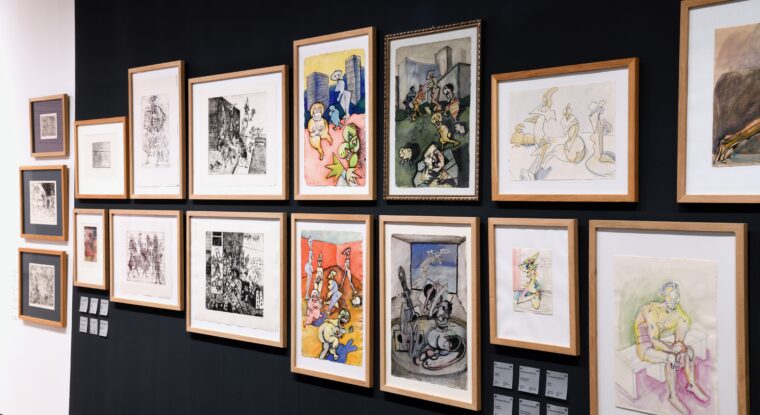
The Cabinet of Curiosities section of the exhibition How to Collect Art: The Karel Tutsch Story introduces visitors to Karel Tutsch’s early collecting activities through a set of ex libris – a collection of small-scale applied graphic art. From here, Tutsch’s interests logically expanded to include fine art prints. Over time, the Cabinet of Curiosities will present various artists and their works on paper that form an indispensable part of the collection.
Detail
The concept of the historically focused collection exhibition How to Collect Art: the Karel Tutsch Story will be expanded by a series of exhibitions of the youngest generation of artists, current students or graduates from art school studios. In this way, the curators will revive Tutsch’s basic strategy of discovering and presenting the works of previously unknown artists in a new context. Gallery Na bidýlku II will thus become a laboratory for new approaches to the traditional medium of painting and installation, whose transformations Tutsch has followed and supported for several decades.
Detail
The use of cultural tools to criticise consumerism is as old as consumerism itself. Artistic critiques of capitalism date back to Germany’s socially engaged expressionism of the 1920s and 1930s known as New Objectivity. The progressive representatives of New Objectivity engaged in their first critiques of consumerism at a time of constant economic crisis and economic downturns, which eventually proved fatal to the Weimar Republic. New Objectivity was similarly adopted by Czechoslovak avant-garde artists with close ties to German culture, including the painters Adolf Hoffmeister, Antonín Pelc and Otakar Mrkvička. Sharp criticism of consumerism can also be found in the early slapstick films of Charlie Chaplin and, in Czechoslovakia, in the theatrical revues and film comedies of Voskovec and Werich and in other early films that, paradoxically, were a product of consumer culture. In the United States during the McCarthy era, pop art focused on the widespread consumerism that had sprung from the post-war economic boom, when the increased purchasing power of the middle and working classes resulted in increased consumption. Critiques of consumerism were of course present in all European social and artistic movements of the 1960s, including Viennese Actionism and Arte Povera, or the French New Wave and Italian neorealism in cinema.
Detail
Tears for Fears is a British synthpop band founded in the 1980s. Its name was inspired by so-called primal therapy, developed by the American psychologist Arthur Janov. This form of therapy is founded on an exploration of childhood traumas, which may be the source of problems that last into adulthood. “Tears for fears” thus refers to the healing power of crying as a way of overcoming fear or anxiety. The concept of coming to terms with (environmental) trauma by appropriating pop songs forms an important aspect of the life of multimedia artist Juliana Höschlová and has been a part of her work for several years. An important source of inspiration for this exhibition is the motif of water in the form of a creek near the artist’s home. With the progressive impact of climate change, however, the creek’s visual form and sound have changed, thus confronting us with a number of questions. How to come to terms with the disappearance of something over which we have no control? How to mourn so that we do not succumb to passive resignation but instead find the strength to follow new paths? Can we reconcile ourselves with the fact that the world as we knew it no longer exists and that, in some places, life is becoming impossible?
Detail
The exhibition Puppets & Chairs at the gallery’s White Cube is an imaginative stroll through a puppeteer’s studio. Gallery visitors can familiarise themselves with various chapters in the careers of partners in life and art Věra and František Vítek, see their original and joint works, and listen to the ticking, rattling, and clinking of playing and
non-playing mechanisms. On display are examples of theatre objects and props, presented in a visually captivating space filled with drawings, and a collection of old chairs.
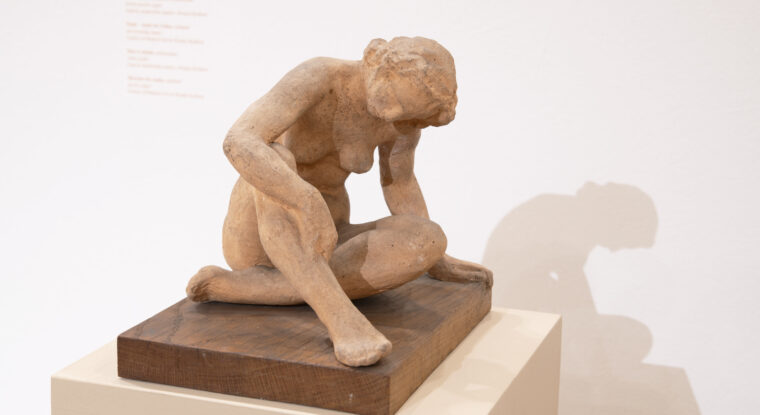
Statues and Statuettes: Josef Václav Škoda presents a cross-section of Josef Škoda’s small-scale sculptural works from the 1920s to the 1940s. It includes works made from a variety of materials such as stone, bronze, pewter, wood, terracotta, limestone, or plaster, alongside several of his drawings. The exhibition follows on the recent showing of Traces of Bronze and Stone: Josef Václav Škoda at GMU’s Vladimír Preclík Gallery, which explored Škoda’s important works for public space in the town of Hradec Králové and its environs. This latest exhibition at GMU features an intervention in the form of a painting by Bohumil Kubišta (Portrait of Václav Rejchl, 1908) and a sculpture by Karel Nepraš (The Confluence of the Elbe and the Vltava As a Grade-Separated Junction, 2000–2001), which will be installed in the gallery’s lobby until 9 June 2024.
Detail
Cabinet of Curiosities, which is part of the exhibition How to Collect Art: the Karel Tutsch Story, introduces the visitor to the beginnings of Karel Tutsch’s collecting through the first section of ex libris – a collection of small purpose prints, the logical continuation of which was the expansion of interest in free graphic art. The Cabinet of Curiosities will gradually introduce individual artists and their works on paper, which are an indispensable part of the collection.
Detail
The concept of the historically focused collection exhibition How to Collect Art: the Karel Tutsch Story will be expanded by a series of exhibitions of the youngest generation of artists, current students or graduates from art school studios. In this way, the curators will revive Tutsch’s basic strategy of discovering and presenting the works of previously unknown artists in a new context. Gallery Na bidýlku II will thus become a laboratory for new approaches to the traditional medium of painting and installation, whose transformations Tutsch has followed and supported for several decades.
Detail
Cabinet of Curiosities, which is part of the exhibition How to Collect Art: the Karel Tutsch Story, introduces the visitor to the beginnings of Karel Tutsch’s collecting through the first section of ex libris – a collection of small purpose prints, the logical continuation of which was the expansion of interest in free graphic art. The Cabinet of Curiosities will gradually introduce individual artists and their works on paper, which are an indispensable part of the collection.
Detail
The concept of the historically focused collection exhibition How to Collect Art: the Karel Tutsch Story will be expanded by a series of exhibitions of the youngest generation of artists, current students or graduates from art school studios. In this way, the curators will revive Tutsch’s basic strategy of discovering and presenting the works of previously unknown artists in a new context. Gallery Na bidýlku II will thus become a laboratory for new approaches to the traditional medium of painting and installation, whose transformations Tutsch has followed and supported for several decades.
Detail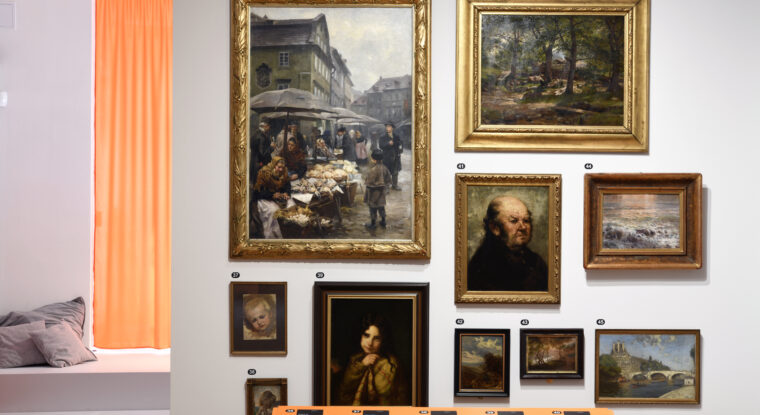
This exhibition features more than 200 paintings from the collections of the Hradec Králové Gallery of Modern Art as it celebrates its 70th anniversary. The works on display range from the late 18th century to the present day. The exhibition explores how the canon of Czech (and Czechoslovak) art history chimes with the tastes of contemporary audiences. In pursuit of this aim, the curatorial selection consciously brings together works by well-known painters with pictures by less celebrated, half-forgotten, provincial and even entirely anonymous artists. Unlike run-of-the-mill gallery projects, which naturally involve works that have been culled and critiqued by generations of art historians and critics, here we present visitors with a broad palette of artistic and technical quality that more faithfully reflects the reality of human creativity and gallery collections.
Detail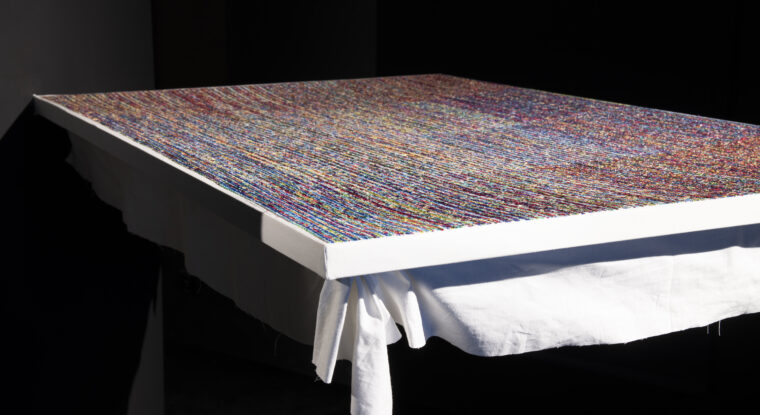
The Gallery of Modern Art presents recent works by visual artist Jana Bernartová (*1983), on display in the gallery’s Black Box exhibition space. The artist’s large-format embroidery Raster ZERO #heroine II (2020–2021) from the series Parametric Digital Structure is presented within the context of works by printmaker Ivan Chatrný (1928–1983) and multimedia artist Milan Guštar (*1963) from the gallery’s collections: Guštar’s audiovisual installation Abacus from 2002–2013 and Chatrný’s Orchestral Composition screenprints from the late 1960s. Both these artists have been of fundamental importance for Bernartová at various stages in her career. While Chatrný’s prints represented a key source of inspi-ration for her reflections on structure during her student days, for Bernartová as an artist with a back-ground in the latest technologies, Guštar’s work is fascinating mainly for how it touches on a broad range of artistic media.
Detail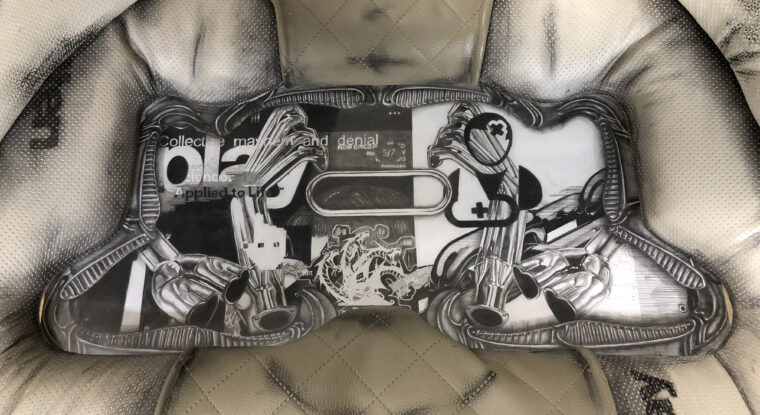
Olbram Pavlíček’s exhibition KORPSEPUNX: Stress Prosthetics at the White Cube of Hradec Králové’s Gallery of Modern Art presents the artist’s latest sculptures, prints, and drawings in which he subversively imitates the design of industrially manufactured products and, through their deconstruction, uncovers the ways in which they influence the lives of their users. Pavlíček subjects devices, symbols, and tools that we know from our everyday lives to aesthetic analysis, showing how their comfortable ergonomics, mathematically precise personalization, or clever visual design hide uncompromising demands. Often, they transform human integrity itself, for living as we do in a technological, consumption-defined environment, we have no control over “our” actions. Instead, we must adapt to the design-determined interfaces of non-human objects. Pavlíček has been exploring this subject in his long-term exhibition series KORPSEPUNX, in which he uses a variety of artistic formats to explore the effects that the complex systems of contemporary societal power have on the individual.
Detail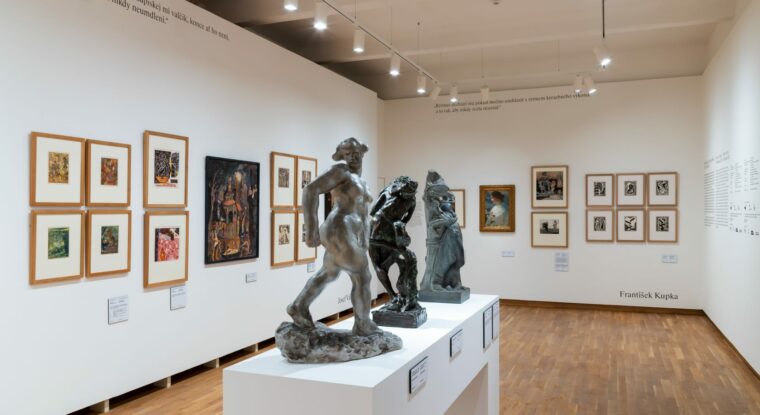
The traditional presentation of 20th century modern art is linear and chronological and typically built on a selection of several characteristic masterpieces assembled into a logical order, usually by grouping various styles. This historical logic is, however, the result of a biased, subjective point of view, created not just by the artists, but also critics, art dealers, collectors, and historians.
Detail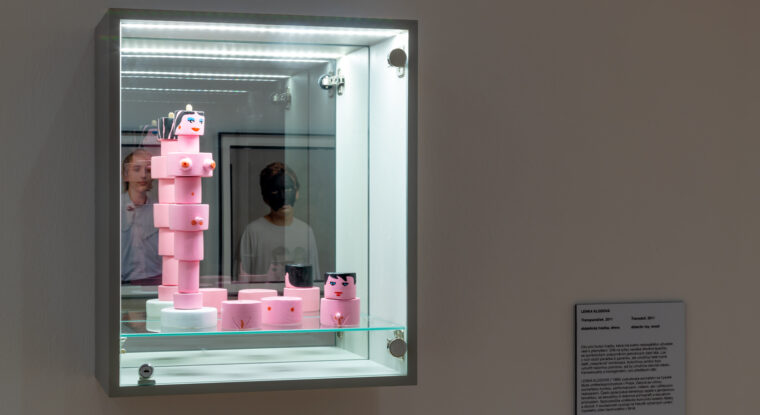
Contemporary art doesn’t have a history, yet. It therefore doesn’t make sense to tell its story in a chronological order. Rather, it makes sense to tell it thematically, with an emphasis on the diversity of approaches by individual artists to their work and to art in general. The exhibition of contemporary art at the Gallery of Modern Art in Hradec Králové is strongly connected to its recent acquisitions. It presents artists from the middle and younger generations, who have been making their way into public collections only recently.
Detail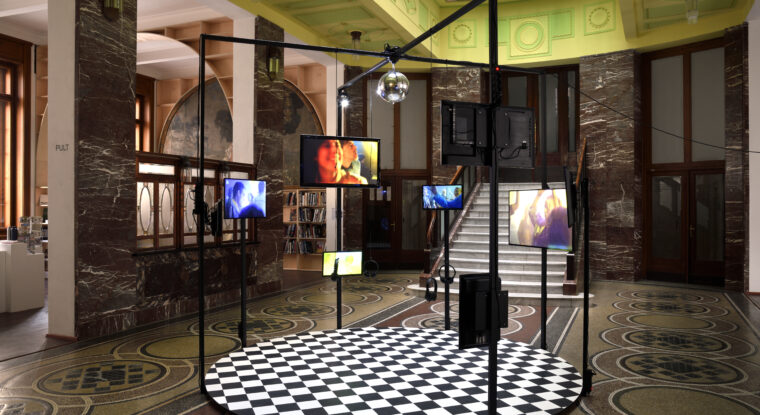
Visual artist Tomáš Svoboda’s multimedia installation Silent Disco (2023), created specifically for the main lobby of the Gallery of Modern Art in Hradec Králové, tries to answer the question of what key factor has influenced Czech society over the past three decades.
Detail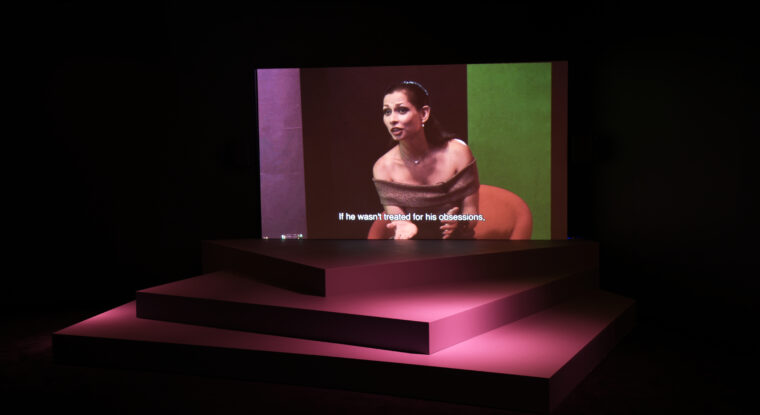
How are an artist’s life and the ebb and flow of her work connected? How does art intersect with interpersonal relationships? To what extent does gender influence an artist’s “career” and the fortunes of her work? Why do we still buy into the romantic myth of the genius whose incomparable work is inevitably derived from an existential struggle and suffering? How does this myth inform cultural relations and shape social contours, i.e. the bedrock out of which all art grows? What role does the media play in the forging of such heroic myths? These and other fundamental questions are posed by Adéla Babanová’s Let’s Talk about Eva (Promluvme si o Evě).
Detail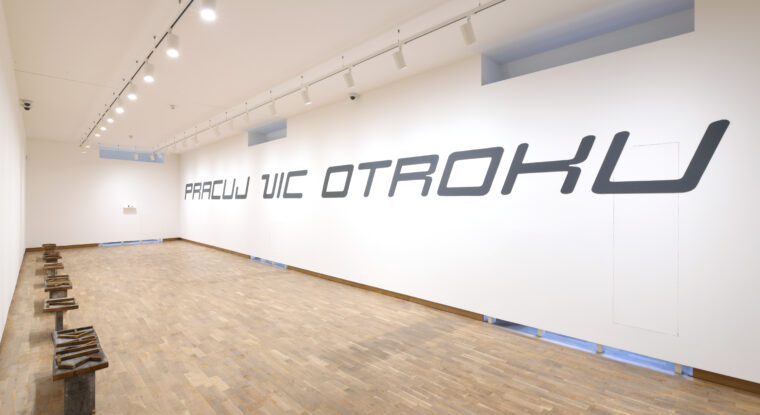
The art of Ivan Vosecký tends to defy any straightforward reading and interpretation, probably because, in its own peculiar way, it exposes the ambiguities and contradictions of the art world and the broader world we live in. Although the artist’s works may come across
at first blush as overly blunt, elemental or provocative, they almost always delve into fundamental questions about our existence.
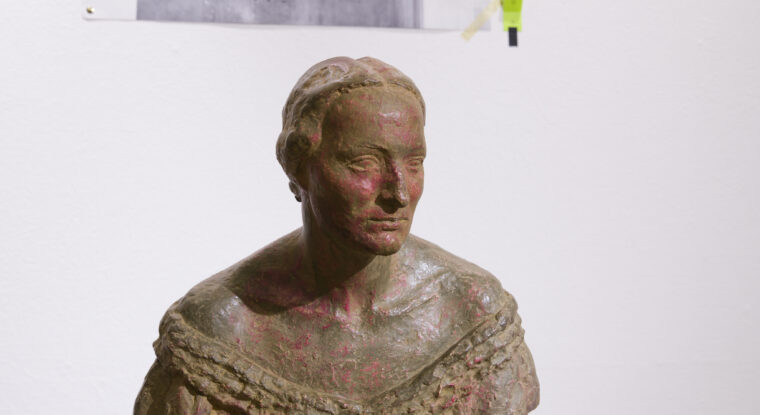
Josef Václav Škoda (1901–1949) was an important interwar sculptor with close ties to Hradec Králové and the city’s surroundings. His works for the public space helped to shape an important era in the city’s history thanks to which Hradec Králové came to be called the “salon of the republic”.
Detail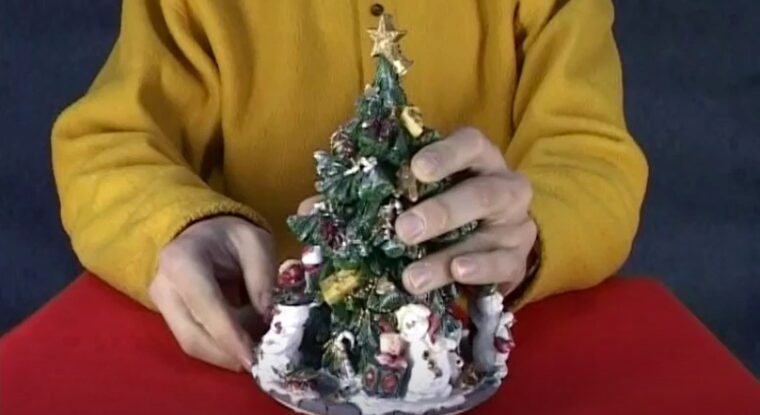
The Christmas holidays overlap in time with the original celebration of Dies Natalis solis invicti (The Birthday of the Unconquered Sun), when the ancient Romans celebrated the winter solstice. This feast was a week full of various social and religious rituals. During one of these, the Saturnalia, children were given dolls, families presented each other with decorative candles, and people played a role-switching game in which slaves could act like free citizens while their masters served them. All we have to do is add Baby Jesus to the Saturnalia, and voilà: we have today’s Christmas.
Detail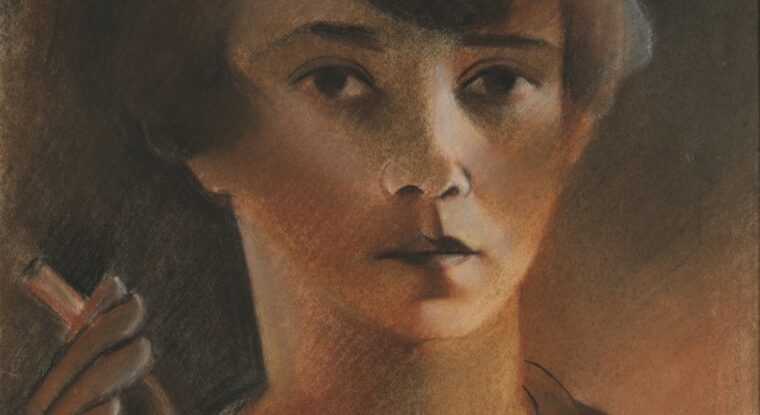
The exhibition of works by Věra Jičínská presents key aspects of the oeuvre of this unjustly overlooked figure of Czech modern art. The selection of paintings, pastels, drawings, prints, and little-known photographs outlines the evolution of Jičínská’s work during the interwar era, when she studied, worked, or exhibited in Brno, Munich, Prague, Paris, Brittany, Pécs, and Dobruška. But the exhibition also looks at her work in the field of applied art, in which she was active after the Second World War.
Detail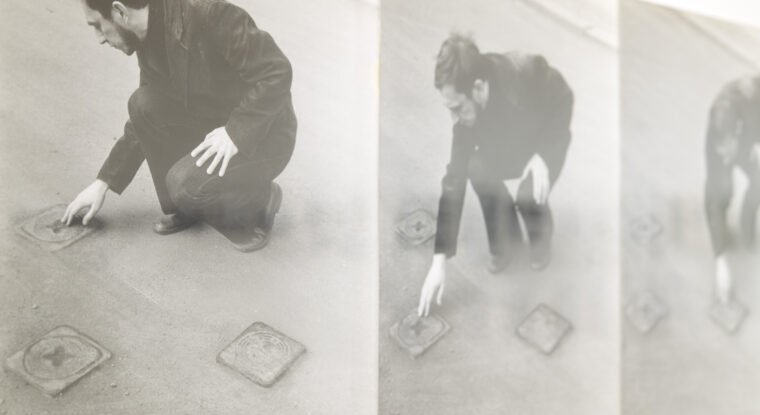
The exhibitions of action art in the White Cube and Black Box introduce viewers to this artistic phenomenon. The White Cube presents works made predominantly in eastern Bohemia that the gallery acquired over the past two years. These are supplemented by other important works of this type from the gallery’s c ollections that were made elsewhere in the Czech lands. In the Black Box, visitors can view films, videos, and documentation of action art from the gallery’s Moving Image Collection.
Detail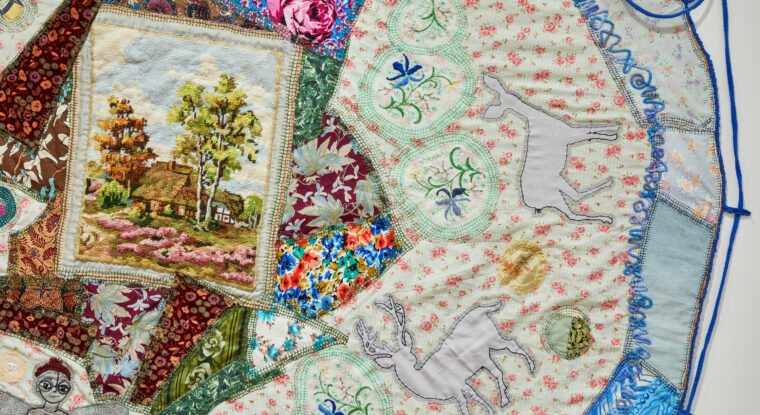
Světlana Pavlíčková is an important artist from the Hradec Králové region, a lacemaker and a designer of crochet patterns. The exhibition Na dotek | To the touch presents the author’s comprehensive understanding of textiles based on the connection of their visual and material side with the cultural, social and historical context.
Detail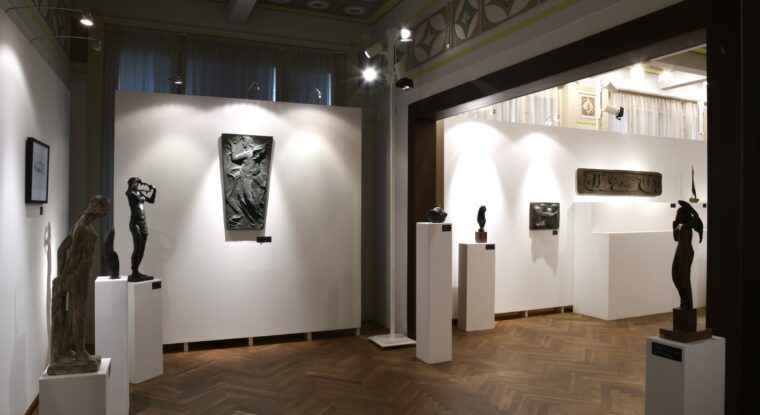
The landscape under the Krkonoše mountains in the north of the Czech Republic is not only scattered with Baroque monuments, large and small, but is also home to a stonemasonry tradition which continues the legacy of the 18th century sculptor Matyáš Bernard Braun, and his followers. The name Wagner is synonymous with this tradition, and first appears in parish registers in the regions of Jaroměřsko and Královévodsko as early as the 18th century.
Detail
Michaela Vélová Maupicová is primarily known as a painter, but her work needs to be viewed as essentially multimedia, process-oriented, and always open to experimentation. The motifs that the author focused on in her paintings have their counterparts or parallels in drawings, prints, and objects, as well as in photographs and videos that reveal a lot about her contemplating. The exhibition “Noise in Honeycomb, Light in Tumulus” presents a selection of short video art works by Michaela Vélová Maupicová that have only been marginally presented to the public.
Detail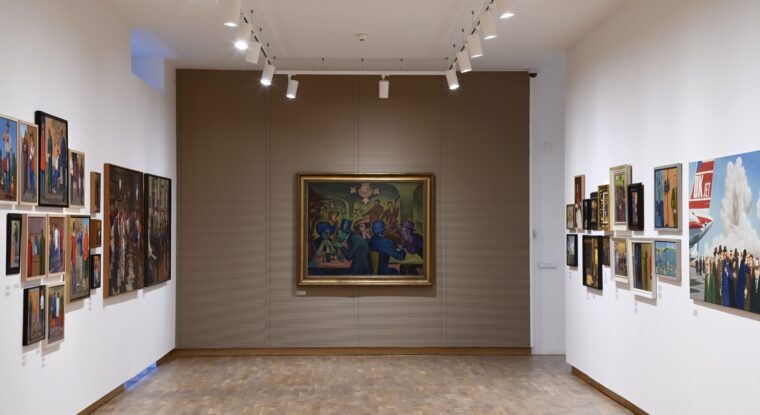
The exhibition presents a cross-section of the work of a native of Hradec Králové, a painter and world traveler who transformed his fascination with the visible world and its absurdist poetry into an inimitable painterly celebration of human society. Through key works from various decades (from the 1960s to the present day) – further complemented by an extensive set of drawings – visitors to the exhibition can follow the gradual crystallization of the artist’s visual poetry.
Detail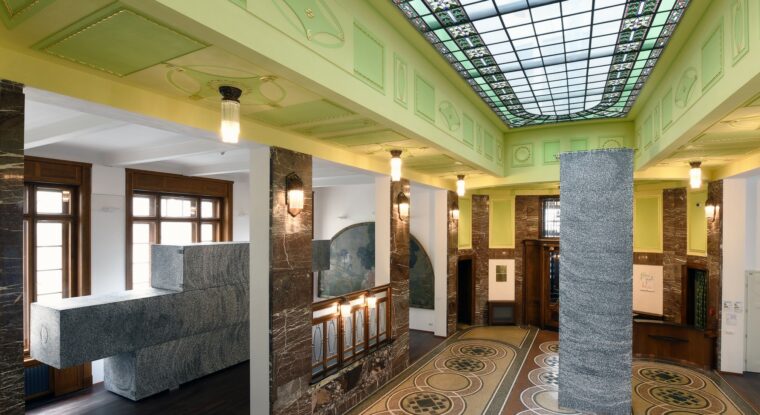
The monumental and decorative Foyer of the Hradec Králové gallery used to be the entry hall of a bank. This space inspired Ladislav Jezbera to create an installation reacting to the monumentality of the entry hall as well as to the noble material used in its grandiose decoration – marble. The black-and-white annealing of the five-meter-long polyester blocks, from which he created three independent objects, is supposed to imitate the structure of the marble. Even the industrial mode of production used to create the blocks reminds one of the process through which marble forms in nature, including the accidental mixing of light and dark particles. The artist thus knowingly works with similarity and contrast between the marble paneling of the Foyer and the economically more accessible artificial material, the overproduction of which by “egocentric” humans is overwhelming the planet. It is as if, with their monumentality, the statues seek to compete with the entry hall. In the end, however, their “mimicry” causes them, rather, to blend into the space while also architecturally completing it and expanding the ways we can perceive it as spectators. The statues are ecologically and economically gentle – the borrowed, prefabricated polyester will be returned to the manufacturer after the end of the exhibition to be recycled.
Detail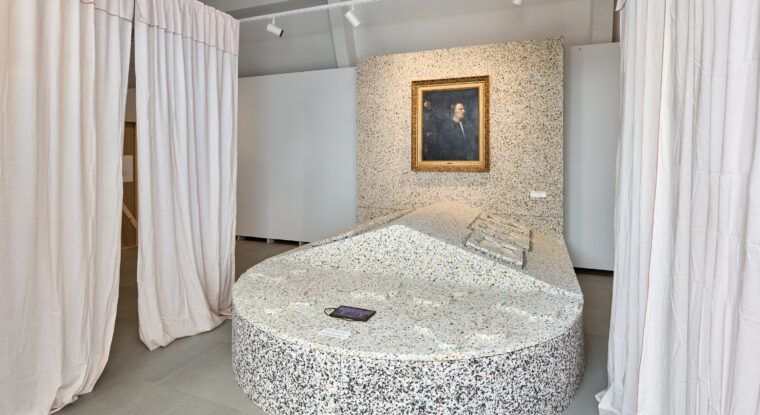
The story of Christopher Columbus, his epochal voyage, and his “discovery of a new continent” are among the founding myths of modern Western civilization. This story, based (among other things) on the study of historical sources, has found a place in history and geography textbooks. Many historical and adventure novels, paintings, prints, sculptures, films, operas, and plays have been dedicated to Columbus. His popularity grew especially in the 19th century and reached a peak at the World’s Columbian Exposition (1893), which celebrated the 400th anniversary of his “discovery”. The public image of Columbus began to change in the 20th century, especially after the Second World War, when anticolonial struggles produced new geopolitical and economic relationships. Gradually, all the things that had long been ignored and suppressed began to bubble to the surface of what had been a grand and triumphant story.
Detail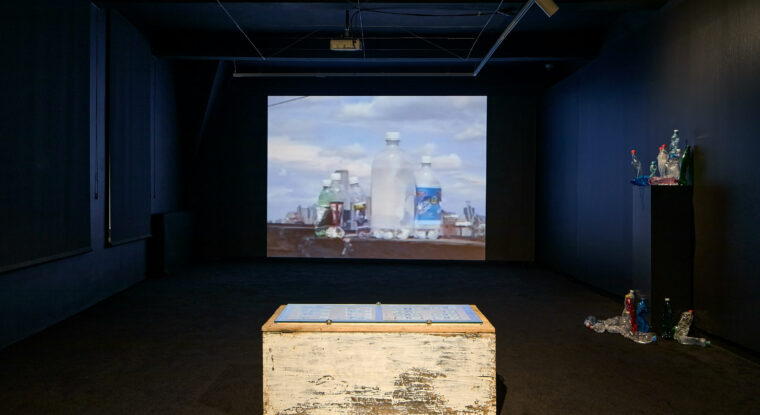
Sculptor, performance artist, and multimedia creator Martin Zet presents his video Cheap Statues (Laciné sochy, 1999) in the Black Box. Filmed in New York in 1999, the video is part of GMU’s Moving Image Collection. In the film, the author explores the similarity in form and absurd dissimilarity in content of skyscrapers and plastic bottles. The video shows plastic bottles being filled with hot water and comically keeling over against a background of skyscrapers. Today’s spectator might view the video through the lens of the events of 11 September 2001, which retrospectively imbue the video with another layer of meaning.
Detail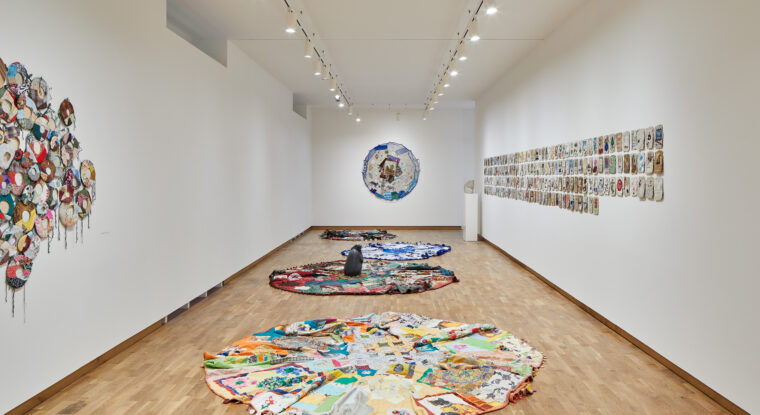
Světlana Pavlíčková is an important artist from the Hradec Králové region. A lace designer, she here presents her work Milieu, an ongoing project spanning many years, in the space of the White Cube. Many pieces from milieu – whether in the form of an embroidered doily or an opulent tablecloth – are created with vintage or found objects and, as well as being a painstaking work, are testaments to personal experiences and stories, while offering a refuge from the world. Besides a fine sense of aesthetics, Světlana Pavlíčková’s work is characterized by her lace-making background, a love of textiles, and a desire to collect a variety of objects. The exhibition is complemented with statues by Karel Hyliš and Miloslav Chlupáč from the collection of the Hradec Králové Gallery.
Detail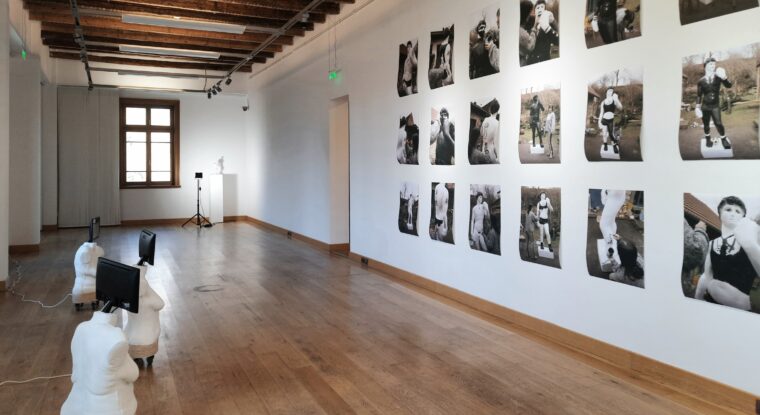
Lenka Klodová’s solo exhibition presents works combining the performative and sculptural approaches that the artist has distinctively applied in her work since the 1990s. The exhibition’s main theme of gender and cultural stereotypes was developed for the Czech Republic’s Presidency of the Council of the European Union. For this reason, it is dominated by David cerný (2009–2022), Klodová’s response to the well-known Czech artist’s Entropa, made by Cerný in 2009 on the occasion of the country’s first EU presidency and exhibited in the atrium of the Justus Lipsius building in Brussels. Cerný’s work produced a strong response in the media and on the political level, in particular because of its representation of Bulgaria. Closely related to David cerný is Klodová’s second piece in the exhibition, Geo-Men (2012), which uses a sculptural approach to depict the contradiction between the various figures’ shape and their shadow and thus speaks metaphorically to physical stereotypes and the social status of men and women. A performative and sculptural approach also characterizes her third installation, Torsos (2021), which combines casts of Klodová’s female relatives with recordings of her performances.
Detail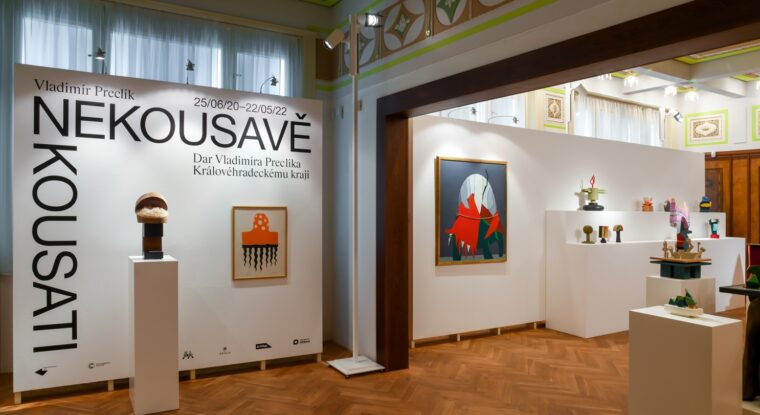
In 2008, Vladimír Preclík donated a collection named Vladimír Preclík Gallery to the Hradec Králové Region. He assembled this himself, in order to create a retrospective overview of his entire work, from its beginnings to the mature works.
Detail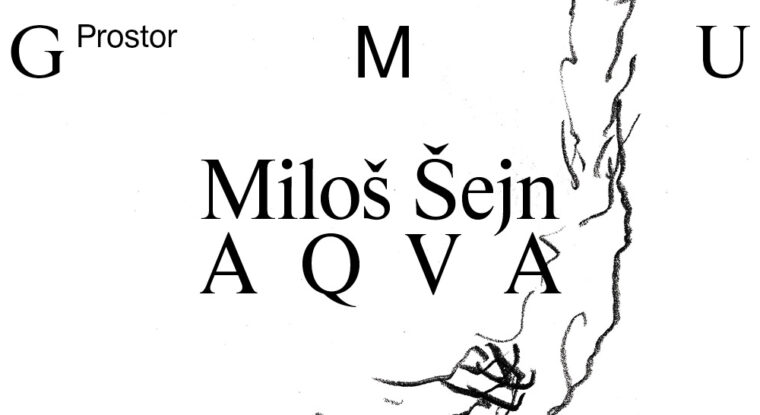
The exhibition presents a selection of over 20 works by Miloš Šejn from his oeuvre, starting with works from the end of the 1960s all the way to contemporary videos and two site-specific installations created specifically for the Gallery of Modern Art in Hradec Králové. The overarching theme, as the title of the exhibition suggests, is the element of water. It appears here in various forms and states of matter and allows one to compare a broad range of approaches to the water and landscape the author explores.
Detail
To what extent can we transmit exact visual information to those around us? Are we capable of truly deciphering the emotional charge important to the author of a visual work? The work of Eva Jiřička presented in the Black Box emerges from the attempt to deepen our visual imagination, understand how we share it, and how we transmit signs and symbols. The artist’s current work concerns itself, among other things, with uncovering the differences in the motifs internalized by this or that generation. In this way, it also indirectly illuminates the development of depictions in various epochs. It follows the collective mechanisms of reading paintings and the ability of individuals to reproduce and interpret symbols, be it captured by memory or transmitted through language.
Detail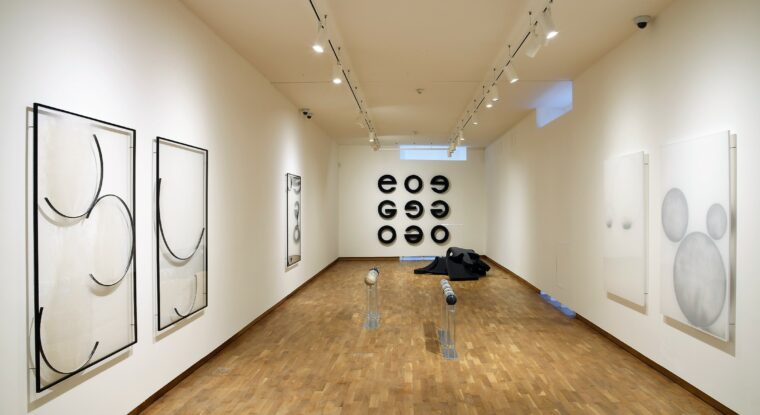
In the White Cube, the author uses an almost scientific and biological approach to explore how genetic predeterminations shape our “I”. They are coded into every cell of our body. Circular elements allude to cell structures, which the author enclosed in plexiglass hanging images (the series Horizon of Events (Horizont událostí) and Eukarya, 2022) along with powdered pigment. When the two sheets come together, a static field causes the powder to expand and form a “drawing”, forever locked into the frame and therefore unchanging, similar to DNA. The motif of the circle also symbolizes cyclicity – the regular movements of celestial bodies influencing human behavior, or the starting point – “horizon” – of our personality’s growth. The collection of marble objects XY (2020–2022) represents a male chromosome transformed into a “bar code”. The individual parts of the work may, in their attacking shape or position, evoke weapons such as bombs, which remind us of the fact that the most fundamental and often darkest events in human history have to do with the male element.
Detail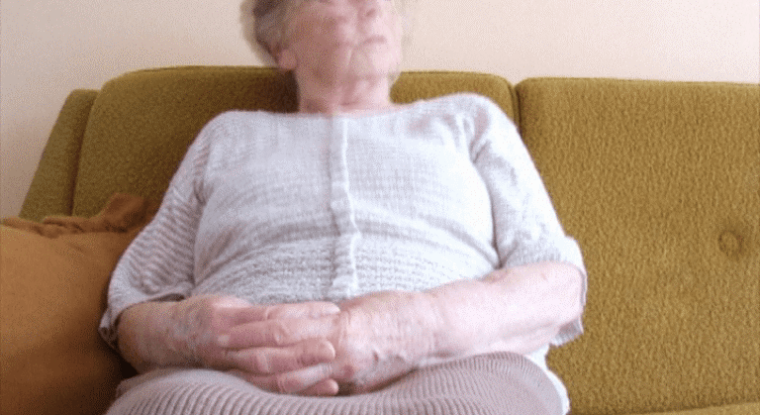
Have you ever suddenly paused and realized that you can’t remember the last two hours, as if time had just disappeared? In the video Exemplary Defects (Příkladné nedostatky) created specifically for the Gallery of Modern Art in Hradec Králové, artist Tereza Velíková focuses on the theme of time loops as it relates to loss of memory. She draws inspiration from her own experience and the experien-ces of people around her. Although the artist is not exploiting a trend or theme which is in vogue, the video she presents proves that the themes she is working with are relevant today. Being overloaded with work (or other things) has become a phenomenon of recent years, as an increasing number of people have been trying to find a way to replace their, often unnecessary, productivity with something more meaningful. Velíková does not offer an answer to this issue – nor does she want to. She only wishes to employ the brevity of visual expression to capture the feelings many of us have faced lately.
Detail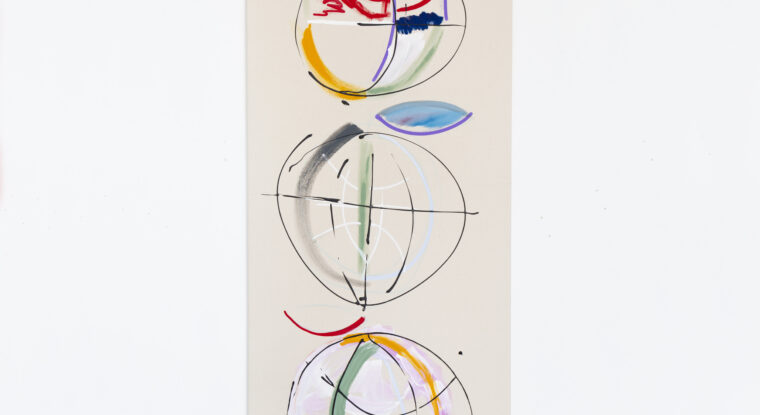
The title of this site-specific exhibition for the White Cube alludes to the marketing term “sales funnel”, which refers to the effort to push a product through the widest possible channel to its destination in the shortest possible way. The bitter current situation of rising prices, growing geopolitical conflicts, the omnipotence of the media alerting us to the global crises, on top of the constant balancing of the individual between procrastination and overwork, leads Jiří Pitrmuc towards a need to observe our routine activities which we gradually, as time passes and new technologies evolve, make easier for ourselves by using tools and machines. The author repeatedly asks himself, however, if this advancement is truly progress.
Detail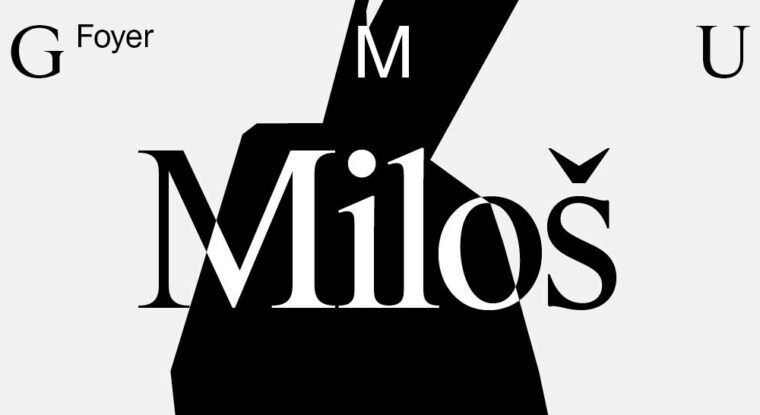
Sometimes, something or someone passes through our lives. These encounters do not need to take the form of dramatic twists, like those from Hollywood films. They’re usually just small moments — a brief meeting of the eyes, a ripple in our attention, or a touch, such as someone brushing past us, or something clinging onto us. These aren’t clear signs, but rhythms of suddenness and waiting, of being close, or of being reserved. It is precisely these encounters which fulfill Proust’s great novel about small things. And it is this sensitivity and these values which art attempts to express.
The work Miloš emerged from the author’s meeting with a stranger — he appeared to her as the back door of a tram opened. He stood, relaxed, without a hint of discomfort, pensive, with a plastic bag clinging to his left leg.
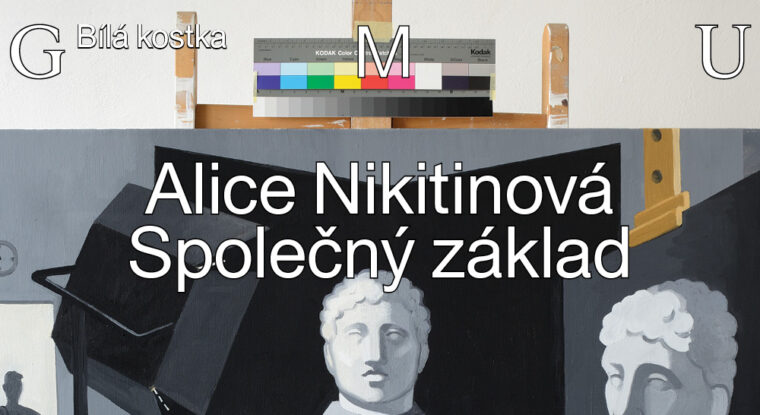
The gate of a picket fence in the painting Old School (Stará škola, 2019) by Alice Nikitinová remains slightly cracked, just enough for one high school girl to slip through. The pictured buildings are plain blocks depicted without real light, shadow, filth, decoration or architectural ornamentation, while regular rows of windows give each floor the same rhythm. Unacquainted spectators might hesitate as to whether they are looking at a prison, hospital, or an office employing one of Kafka’s heroes. A school may be the most unlikely option to occur to the average viewer. All these institutions are organized according to internal rules which reflect the social norms of criminal justice, healthcare, or education. Surprisingly, however, the impetus for this painting was not an effort to create a critical depiction of authoritative, gatekeeping institutions, through which the author progressed in her youth and where she spent days and weeks drawing classic busts or live models.
Detail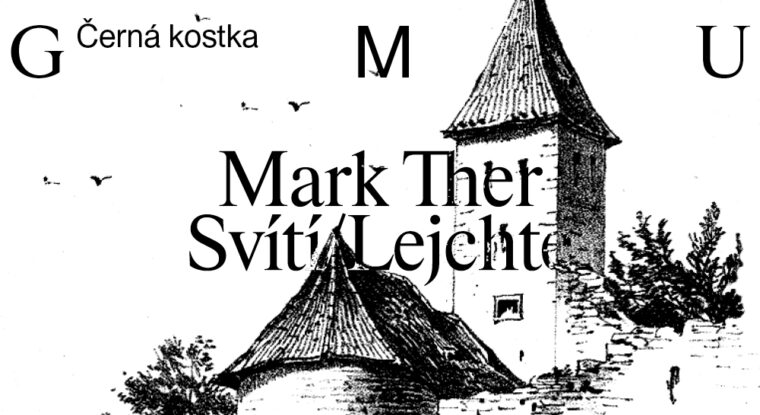
In the Silesian German spoken around the town of Broumov in the Sudeten region of the Czech Republic, the word “alight” is translated as lejchte. We might perhaps imagine Mark Ther carefully screwing in a light bulb and, with palms facing up in an elegant, but comical, gesture, stating that the original light borrowed from a first Czechoslovak Republic villa for an exhibition at the Gallery of Modern Art in Hradec Králové, is alight. The Czechified spelling of lejchte, a word which, in standard German, would be leuchtet, points to something grammatically incorrect. This deviation from the norm is also testament to the emergence (or perhaps betrays the emergence of) a specific cultural identity, in this case that of the Sudeten region.
Detail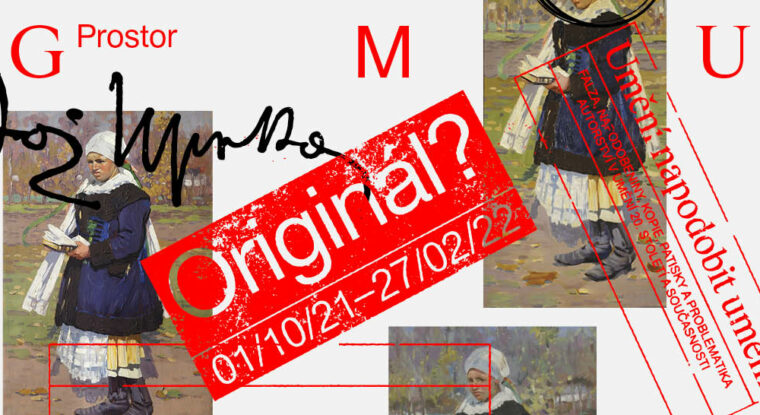
This exhibition explores the phenomenon of original works of art and their various falsifications, from copies to intentional forgeries. The period under investigation covers the first half of the 20th century to the present day. The exhibition is methodologically divided into six sections, according to techniques, procedures, and approaches to creating forgeries. Each section consists of paintings, drawings, graphics, and sculptures,
as well as photographs, conceptual works, and new media. Because falsifications are dependent on the market for their “survival,” the exhibition explores them not only through the lens of art history, but also from a legal perspective, allowing a broader inquiry into falsification as a social phenomenon.
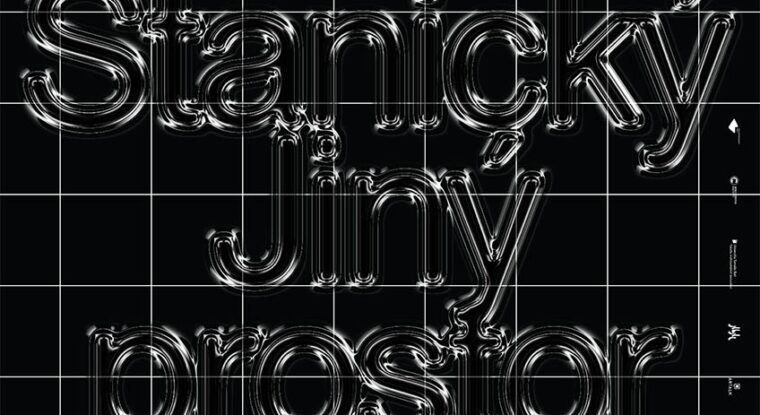
Featured artists: Petr Stanický spolu s vybraným autorem.
For this exhibition, Petr Stanický has created an entirely novel site-specific installation which, through the imaginary Window of Zlín and Flowing Through, opens the closed space of the part of the gallery referred to as White cube. This space cannot be penetrated by daylight and reflects the clash of these two utterly different worlds. These changes in optical characteristics simply through the use of light or choice of angle have become the point of departure for this exhibition. In his other installations, just like in all of the author’s work, we find a distinctive sculpting style that communicates with the surrounding space from which it draws inspiration.
Detail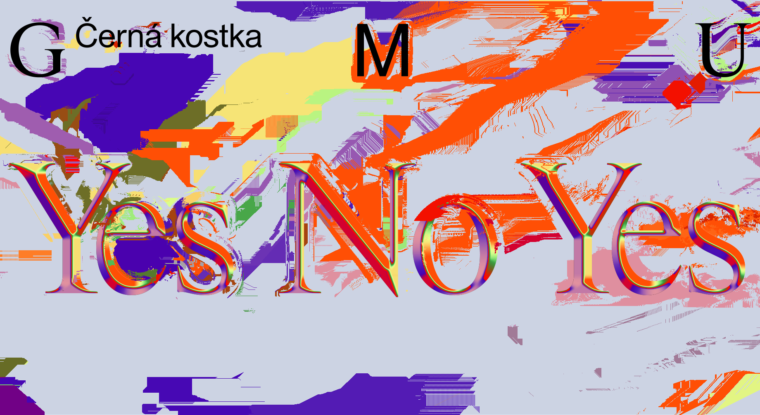
The Yes No Yes exhibition takes its inspiration from questions connected to the environment and circumstances leading to the emergence of the moving image. The aim is to follow a range of effects (sometimes called “special effects”), the manipulation of the image, and spontaneous gestures which influence them in their making. The inspiration for the exhibition came from the first Czech video artists, who often used video technologies in very intuitive ways. The video as an object in and of itself carries historical significance related to the development of the audio-visual arts, while simultaneously being connected to contemporary ways of grappling with what is known as the moving image, not only in the context of cinematography and visual arts but also in, say, music, fashion, and other forms of pop culture.
The exhibition borrowed its name from the video Yes No Yes (1992) by Radek Pilař – a painter, illustrator, experimental animator, videographer, arts organizer and pedagogue. In the 90s, Pilař participated in the foundation of a workshop focused on electronic animation at the FAMU film school. He also worked shortly at the Faculty of Fine Arts (FaVU) at the Brno University of Technology, where, in 1992, he became the first director of the atelier for electronic multimedia art – today’s Video Atelier.
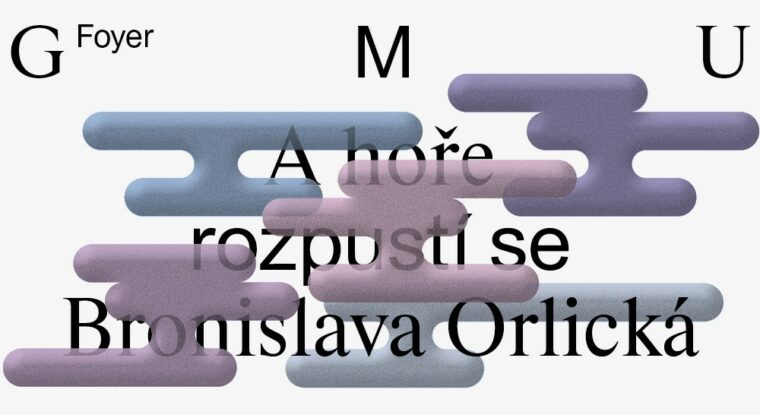
The central motif of this exhibition is a single work – the lithograph Woe (Hoře) – by Jan Zrzavý, from the year 1918, which is in the collection of the Gallery of Modern Art in Hradec Králové. An allegorical, heavily stylized head is placed diagonally onto the space of the canvas, with a round white shape on its forehead, half-closed eyes, a sharp nose, and a teardrop on its left cheek. Figural motifs dominate the work of Jan Zrzavý. He was
interested in humanity, its feelings and experiences. When Zrzavý drew landscapes, he did not stay out in the open to sketch them, like most painters, but took inspiration from his own imagination. We find this same stylization of invented landscapes and emphasis on inner worlds in the work of Bronislava Orlická. She believes subtlety is one of the most compelling aspects of Zrzavý’s work, and is something which renders it relevant to this day. The space of the White Cube is ideal for the uninterrupted interaction of both artists and their common story, which transcends the confines of the picture frame.
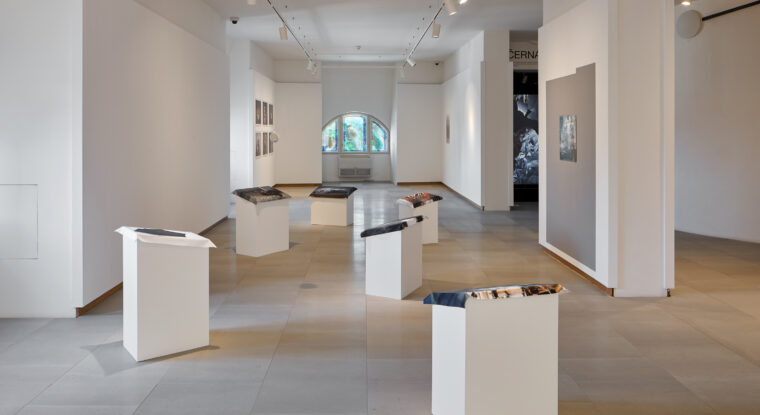
For most of us, intimacy is the most distant corner and deepest content of our private lives. In communication, it is facilitated by the highest form of trust. The prickly Latin word intimus means the “most secret” and “most inner” as well as “most intimate”. It is an important issue of our historical and cultural condition that these most hidden, most intimately relayed, truths are the main focal point of artistic expression.
Detail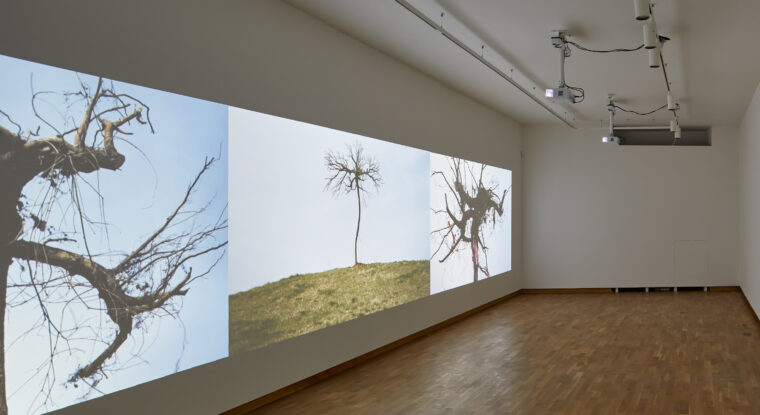
The Gallery of Modern Art in Hradec Králové is displaying the latest work of Tereza Severová (*1979) at the Bílá kostka (White Cube) exhibition room. It is a three-channel video projection called Tree in the Middle of a Landscape (Strom uprostřed krajiny, 2021), in which the artist concludes her ongoing exploration of the theme of trees as significant elements of the Czech landscape, imbued not only with environmental but also symbolic and political meaning. Severová’s work focuses primarily on photography, moving images, and their digital manipulation. Through these mediums, she tests the meaning of traditional social values like freedom and democracy, the evolution of the perception of freedom and democracy, their loss of content, and how their meaning changes over time. Recently, the artist’s attention has been turned with increasing frequency towards the relationship between the individual and the landscape, especially the post-industrial landscape, which we have, to a certain extent, been taught to see as a mediated image, which we cannot alter. Thus, the landscape, utilized as a projection screen of (un)realized visions, longings, collective and personal rituals and creative gestures, becomes a meeting point for an unexpected layering of dialogue between the author and generationally-distant but, in certain aspects of their work, surprisingly related artists – Ivan Kafka (*1952) and Dalibor Chatrný (1925–2012).
Detail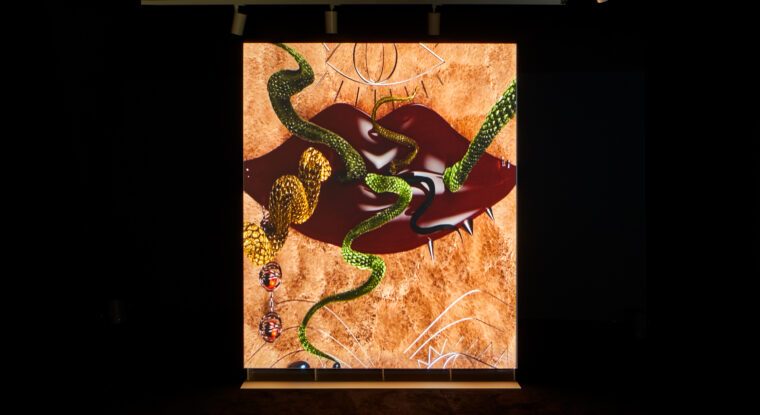
In a world of aspirational images, enterprising young women and magic spells, monsters, body parts and machines emerge from and dip back into animated surfaces of saturated color. The camera sways to a rap beat, scanning the landscape from horseback, where vaginas grow through rock while children’s voices sing of neverending debt. In the solo exhibition Frugo, Marie Lukáčová uses her highly developed artistic language to present image as a tool for the production and control of desire within global capitalism.
Detail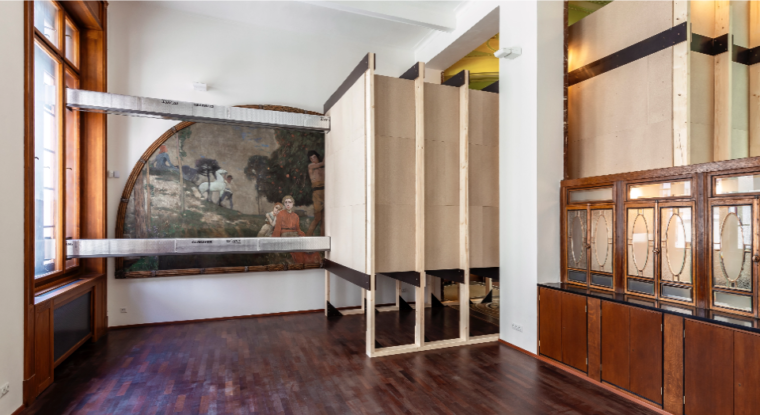
Artist Dalibor Bača’s intervention Za kulisou / Behind the Scenes consists of physical architecture, a chamber which is sunk into the entry hall, and the artist’s own performance within this chamber. Over the course of 9 months, the artist will make three week-long stays within the dark and soundproof space he created. The chamber is fit only with a bed and bathroom and he will have no access to food, news from the outside world, or human contact of any sort, including media and social networks.
DetailAn exhibition of key artworks from Karel Tutsch Collection, which GMU acquired in 2021.
Detail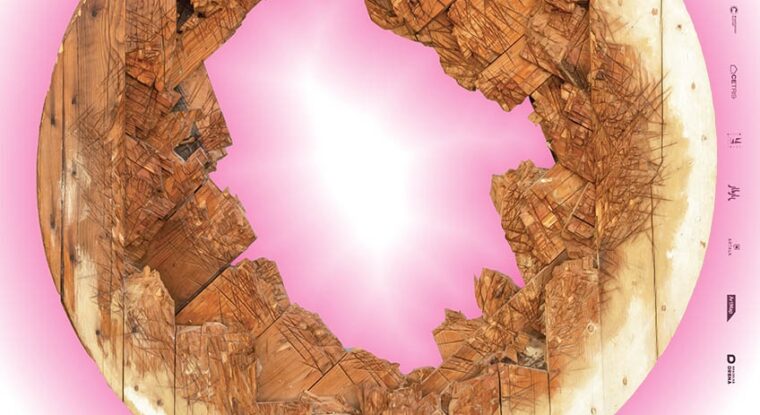
The basis of Jiří Hilmar’s work is the theme of space, which he understands not just as a three-dimensional delineation but also as an environment, a milieu, the historical and social aspects of which are shaped by humans. To Hilmar, however, the issue of human existence is not a question of the individual but of a relationship in which humans form an inseparable part of a greater whole – that whole being nature.
DetailThe exhibition of Matyáš Chochola is a visual epic and a philosophical reflection on the form of our world, a world of people at a time when the boundaries between reality and dream, idea and subject have already been erased yet. The history of the World in his interpretation are the history of thought and life as such, because we are one of the temporary forms of the energy of the Universe. We are a part of transformations and transsubstantiations of elements which unite us with the beginning of the Universe and persist after humankind even beyond its end. We are the moment of eternal duration without beginning and the end.
DetailPetra Malinová’s exhibition is the essence of delicate beauty that invites us to break away from the news of everyday life. In the artworks we can feel the desire to capture something essential from the reality of life and humility to nature. She collects grasses, herbs and flowers, which she inserts with respect to her paintings, which complements the color pigments and the relief surface of the paintings offers us the opportunity to explore their structure. The drawings most often depict the proliferation of new life forms.
DetailThe current exhibition of Vladimír Preclík Gallery presents a selection of artist´s artworks from the period 1960–1968 that belonged to the creative highlights this distinctive personality of Czech sculpture scene in the late 20th century. The beginnings of Vladimír Preclík´s artistic work were closely connected with Hradec Králové where he was taught to be a carver. He gained sculptural skills at the Higher Technical School of Sculpture and Stonecutting in Hořice v Podkrkonoší, and at the Academy of Arts, Architecture and Design in Prague (Prof. J. Wagner´s studio).
DetailThe project entitled CROSS SECTION / PŘÍČNÝ ŘEZ will present a selection from the life’s work of Jiří Načeradský (1939-2014) through his paintings along with a cross section of the hitherto works of his student Lubomír Typlt (1975). The exhibit follows the living, intergenerational, parallels of expression in paintings against the background of lived experience in any particular historical era. Expressive painting as well as geometrical reductions and abbreviations present in the works of both artists point to the algorithm of the painterly process which is literally experienced as action.
DetailThe exhibition will present a majority from the collection of paintings left to the city of Hradec Králové in 1919 by the Bishop Josef Doubrava for the planned Municipal Gallery. This generous gift, consisting of almost 100 paintings and works on paper, did not make it into the hands of the Hradec Králové Council until 1936 when it was displayed in the old Town Hall building and, later, moved into the museum, only for it to remain, for political reasons, permanently hidden from the eyes of the public after World War II. After over 70 years, the people of Hradec Králové will have the chance to see this beautiful collection, which contains works by František Ženíšek, Vojtěch Bartoňek, František Urban, Max Švabinský, Luďek Marold, Antonín Slavíček, Jaroslav Panuška and other Czech landscape painters.
DetailFeatured artists: Milan Langer and others, Miroslav Podhrázský, Jaroslav Chmelík, Radoslav Pavlíček, Jindřich Max Pavlíček
DetailFeatured artists: Radoslav Pavlíček, Jindřich Max Pavlíček, Jaroslav Schejbal, Petr Vyšohlíd, Michal Tošner, Pavel Doskočil, Martina Hozová, Pavel Sůva, Radek Škoda, Michal Kindernay, Zdeněk Merta, Jan Pražan, Miroslav Podhrázský
DetailPermanent inspiration by the Central Bohemian Mountains and the need to conduct a dialogue between fine art with science laid the basis of the unique visualization of Zdeněk Sýkora´s art. Within the Framework of exhibition will be presented the representative selection of author´s graphic work, that was always firmly connected with his principal painting activity.
DetailIt has now been thirty years since the Free Coalition 12:15 caused a stir with its exhibit entitled Better Late than Never. It was under this, for the public rather eccentric, name that this coalition of Czech artists, who were rooted in the 1970s and established in 1987, first publicly presented itself. At this time, the urgent question of generational coherence rose once again under pressure from official structures but also under pressure from the new, rising generation of artists. In the year 1987, through their numerous discussions, artists of that generation established a free coalition. The founders of the “free coalition” were classmates from the Academy of Visual Arts in Prague Václav Bláha (1949), Vladimír Novák (1947), Petr Pavlík (1945) and Michael Rittstein (1949). Later, they invited Jiří Beránek (1945), Jaroslav Dvořák (1946), Kurt Gebauer (1941), Ivan Kafka (1952), Ivan Ouhel (1945) and Tomáš Švéda (1947).
DetailSince the middle of 19th century Paris has been for many Czech fine artists one of real metropolis of art. The city above Seine river, where modern art rooted, was hope for them. Many came here to draw inspiration from personal encounters with well-known masters, to study the latest artistic trends, or simply be consumpted by the cosmopolitan artistic atmosphere.
DetailOtakar Slavík (1931–2010) is one of the artists who, in the 1960s, re-introduced Czech art into the European context. He is sometimes associated with the movement of New Figuration, but his particular brand of figuration is connected with a background in sculpting, his studies at the sculpting and stonemasonry school in Hořice, and particularly with his deep, lifelong fascination with the human form. After his studies, he formed relationships with artists who were part of the strong generation of the sixties. A basic component of his work was always color, but he also explored issues of structure and order in paintings, which were reflected in the pictoral scheme. In a tragic turn of events, he was forced to emigrate after signing the Charter 77, moving to Vienna with his wife in 1980.
DetailThe warfares of the World War I left their marks on the whole Europe and on the fates of its inhabitants. The painter Jindřich Vlček, the native of Malá Skalice, the student of the Academy of Applied Arts in Vienna, graduated on the Academy of Fine Arts in Prague (Prof. H. Schwaiger), wounded on the Russian front as a soldier of the Austro-Hungarian Army shortly after the mobilization in 1914, and captured in 1915.
DetailThe basic concept of the exhibition stems from free responses to and inspirations by East Asian calligraphy in contemporary Czech art. Ten distinct artists will introduce different approaches to this subject, accentuating mainly the physical and motion perception of energy encompassed in the expressive process of “calligraphy” work.
DetailThe exhibition will introduce the visitor to the massive coal toroids of Jiří Kornatovský (*1952), in which the act itself of drawing, that is, the directed movement of the hand and entire body, is the very meaning of the work. The constant repetition and cyclicality of this coal-produced, DECLARED, movement connects the resulting drawings with spiritual exercise and meditation.
DetailFlowers: their transient beauty fascinated philosophers, mystics, and shamans for centuries and they are a major theme for artists, in whose hands they become full of hidden meanings and speak a language comprehensible only to the initiated.
DetailZdeněk Sklenář´s (1910 – 1986) graphics developed parallel to his work as a painter. In his early work, he finds inspiration in an inner world of fantasy and poetic images, drawing rich inspiration from French poetry (G. Apollinaire, C. Baudelaire) and commedia dell´arte (the film Children of Paradise).
DetailThis retrospective exhibition of the work of Zorka Ságlová (1942-2003) presents a selection of key works representing the basic themes of her art.
DetailFeatured artists: Jonáš Czesaný, Filip Černý, Igor Grimmich, Adéla Janská, David Jedlička, Tomáš Jetela, Lenka Kerdová, Tadeáš Kotrba, Martin Krajc, Petr Malina, Tomáš Němec, Jitka Nesnídalová, Lenka Pilařová, Daniel Pitín, Zbyněk Sedlecký, Tomáš Tichý, Lubomír Typlt, Jana Vojnárová
DetailThis exhibition is a cross-section of the work of Hradec Králové author Radoslav Pavlíček, one of the principle representatives of Czech post-minimalist and post-conceptualist movements. His work is represented in the collections of the National Gallery, the Moravian Gallery in Brno, the Gallery of Modern Art in Hradec Králové and a number of private collections.
DetailBohumil Kubišta is among the important figures of the founding generation of Czech modern art and his work had a significant impact on the development of Czech painting in the pre-World War I era.
DetailFrom newly-acquired works, 2014-2015.
DetailThis exhibition focusing on Aleš Lamr (b. 1943) is a cross-section of the artist´s work, displaying characteristic pieces from various creative periods of his paintings so far, from the (early) 1960s to the present. The exhibition includes the artist´s lesser-known bronze sculptures, polychrome wooden statues and objects, and spatial drawings.
DetailThe head. A relic, a place where we keep our treasures. A place where ideas and dreams are born. A place where good and evil resides. A place where both smile and taunt come from. A place where dreams and visions are born. Where are their boundaries? What was Jiřina Hauková (a Czech poet and translator) to Mikuláš Medek (1926-1974)? We do not know; we can only guess. But we will try, nonetheless.
DetailColours, shapes, area. Nothing more, nothing less. For Jan Kubíček (1927-2013), the white canvas is what a score is to a composer: a place to compose a symphony for elementary shapes and colours. There is an infinite number of options, but the choice is never random. Revealing the rule by which the final composition is a part of this game. Care to join?
DetailJosef Váchal (1884-1969). “He was well versed in nine different trades. A painter and book-printer. He wrote a thing or two. He was an extreme mystic. A fool, a lecher, disturber of pure things, a scourge to his own soul.”. These words were written by Váchal himself to be inscribed onto his own tombstone. Váchal created a portrait of one of his friends Jindřich Imlauf, a writer and a photographer. The portrait shows Imlauf’s face in the background with some whirling circles in the foreground. There is certainly much more than meets the eye to the portrait of Imlauf, “ a poor soul that suffered greatly when he was alive.”
DetailJitka Svobodová (b. 1941), long-time Professor of Painting at Painting Studio of Academy of Fine Arts in Prague, is primarily known for her large-scale black pencil drawings, capturing details of everyday objects. These objects are taken out of their normal context and are placed before their viewer’s eyes as something completely new. As if she were a philosopher, Svobodová makes us see something that we do not perceive and therefore do not see.
DetailSpace and time are two basic concepts that form the framework of human life. What exactly are they? This may seem like a simple question, but it is the one that physicists and philosophers have been trying to answer for centuries. Jiří Anderle (b. 1934) paints his idea of those concepts on the borderline between astral abstraction and harsh realism, depicting the stern reality of death of human beings
DetailZdenek Seydl (1916-1978) made his debut as an artist during World War II. He was a painter and a member of Sedm v říjnu artistic group. He got up to be one of the most interesting Czech artists. Over the years he developed a peculiar style full of playful allusions and original forms of artistic expression. Later, he shifted away from painting to focus on applied graphics, book illustrations, typography, and animated films.
DetailBorn in Holice, Karel Malich (1924-2019) was a world-class artist. He gained recognition thanks to his delicate wire sculptures and luminous pastels. However, he showcases a robust relief this time. Seemingly hard geometric layout hides another layer: intuitive perception of the landscape, of its space and energy. The energy is concentrated at certain places or flows through invisible corridors.
DetailMoonlit night with lovers is a painting depicting pure desire. It is a desire to run away from the unbearably monotonous daily life that seemed bleak and hopeless because of the war. Such was the dream of Karel Černý (1910-1960), a talented painter. Černý’s fate was as dark as the shades of black-blue colour that Černý himself mixed for his paintings to achieve desired depth, texture, and silky sheen.
DetailAntonín Procházka (1882-1945) and Kubín were both members of the Osma artistic group. Procházka, an expressionist, found himself in a struggle what to do next following the events of World War I, which was a tomb of many ideals of the avant-garde. Ultimately, he found his path in a return to bucolic scenes, drawing from ancient tales, aesthetics, and folklore.
DetailOtakar Kubín, also known as Othon Coubine (1883-1969), is an avant-garde painter, who first gained fame before World War I. He was known for his canvas paintings depicting anxiety and colour contrasts. Later, he became commercially successful with a completely different kind of paintings-beautiful landscapes and tasteful portraits in colour.
DetailA wall with flaking paint that arouses imagination, inspired by Vladimír Boudník and his explosionism creations. Two girls who are carrying fanciful bouquets. Summer passion is beginning to burn. Those are all features that are characteristic of Stanislav Podhrázský. Podhrázský, a painter, a sculptor, and an art conservator, is a creator of numerous paintings that are a captivating blend of emotions and ideas, the fantastic and the real, the dreamlike and the banal, the sentimental and the expressive.
Detail